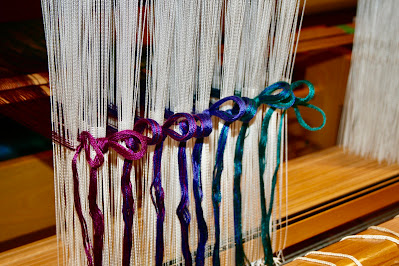You have been very patient and waited for some time.... so right at the top of this post is some 'eye-candy' 🍭
So if I'm down to one loom, and must weave in shorter time increments, then why not have fun with it and try out new ideas, colour blending, new drafts? So I worked from my existing stash and found three tencel colours that are close in value (depth of shade intensity) and work well with each other. Why tencel? Well, I have a lot of it and there are some lovely colours to work with. I used the gradient program in Fiberworks for Mac and did a 3 colour gradation. Some minor tweaks to soften it out and then printed off the colour order.
I wound the warp one thread or a few more at a time on my warping mill, inching little 'post it notes' across the colour guide. The draft I had chosen was very open ended for where the colours landed. No points in the draft to hit the mark, so that is a good thing.
Each of those bouts are hung with 3 pound weights on an 'S" hook. I shifted them every 2-3 feet or so. It was a lot of back and forth but so worth the nicely tensioned warp!
The colours flowed on nicely and looked wonderful! Dark Teal, Iris and Red-Purple
When I took this picture I didn't know that there were two threading errors lurking in that huddle of heddles! 😬

Sleying also had an issue with crossed threads behind the reed. I was feeling like a real newbie and it seemed like this start was the slowest ever!
Then I finally started weaving and this is what I saw.... I'm weaving it upside down! So I'm committed to weaving this one, this way at least. The weft is an old gold / bronze age gold (?) 20/2 silk from Treenway Silks from the stash.
I end up having some difficulty with the far right teal edge thread. No matter what I tried, it would fray and break. Advance the warp more frequently, sit closer to the right on the bench, subtley shift the reed in the beater. I checked for spurs on the dents. Lifted the floating selvedge up at the end of a session so it doesn't unwind the plies.... and so on. Eventually, I could see when it was starting to soften, and I would lift and pin the selvedge thread and start again. It was easier to needle weave stronger ends in than wispy bits of nothing!
Here is the result of the first scarf.... and now you can see the right side. Its more warp dominant one side, weft faced the other.... but you know, it works nicely to compliment the whole scarf. The back side does have a ghosting of the pattern visible. As you can see from the pictures.
So for scarf number two I had to audition some new colour choices....and there was no silk in something suitable unfortunately. I found this salmon shade in tencel. They've tried calling it other names such as red clay etc. I called it the right colour ! I also wove this one upside down and decided that I liked the big reveal when it came off the loom and so would be a surprise.
The salmon is rather powerful, but still melds all the colours with a blush of colour throughout. It's my favourite of the two scarves.
They measure 9 inches wide by 73 inches long, plus the swishy fringe.
This is the draft I used and you may notice somethings are missing. This is not my draft, or come from a public source such as handweaving.net or other places. Its not mine to share and credit must be given to the designer / author.
You will find this 16 shaft draft here in this book, on page 122, by Janna van Ledden who designed this and other drafts inside and authored the book. It has drafts for 8 shaft to 32 shafts and is presented in both Dutch and English. I do recommend reading the section on how to use and read the drafts *first* and to also seriously bump up your heddles on shafts one and two. Or at the very least count them against the draft. It's a twill and half basket weave as was related to me by Marion Stubenitsky.
There really aren't much for fresh inventive weaving books right now but this book and also Marion's (such as Echo and Iris) are ones for your book shelf.
🌷🌷🌷


















